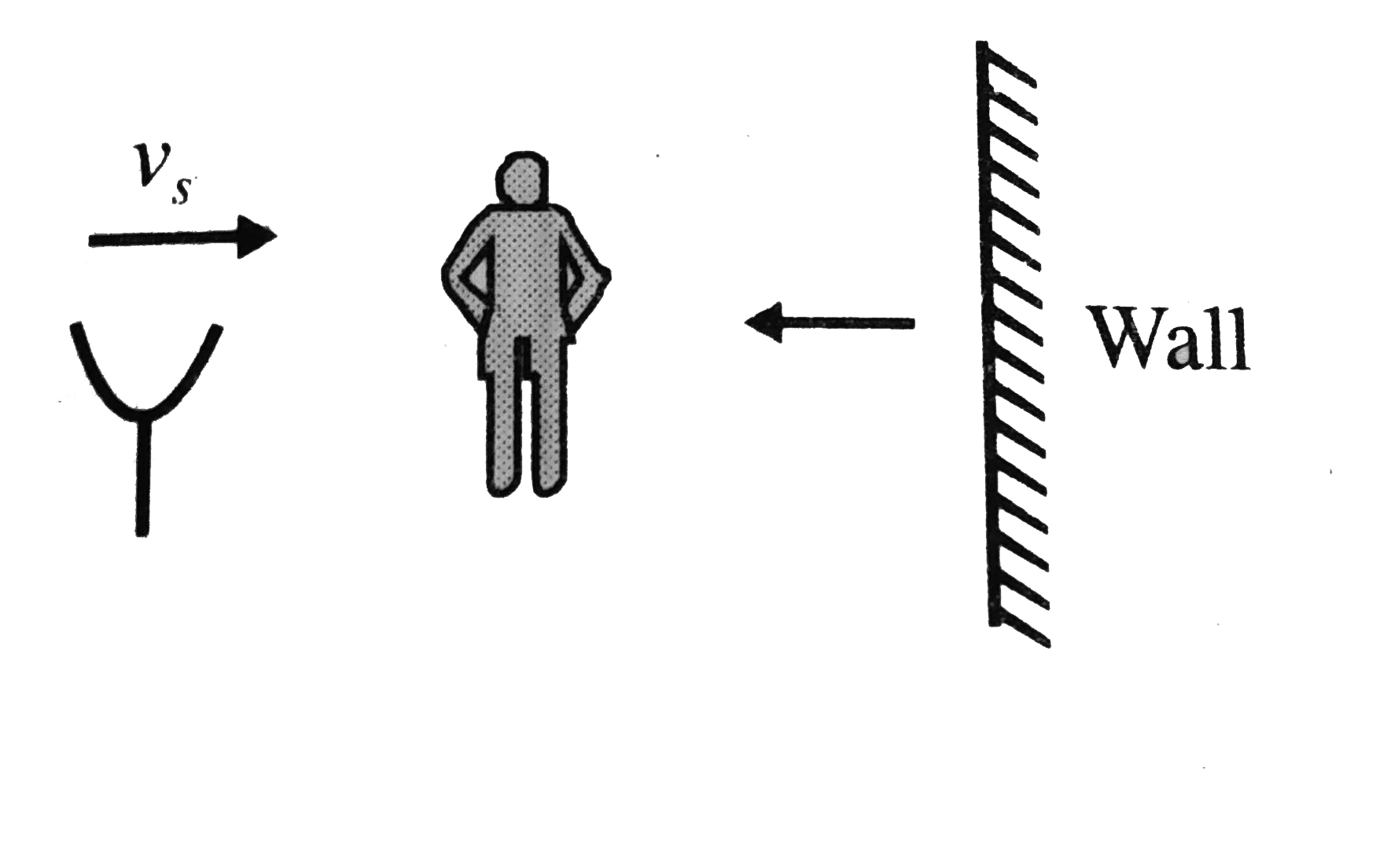An engine blowing a whistle of frequency 133 Hz moves with a velocity of towards a wall from which an echo is heard. Calculate the frequency of the echo heard by the driver. (velocity of sound in air in .)
To solve the problem of calculating the frequency of the echo heard by the driver of the engine blowing a whistle, we will use the Doppler Effect formula. Here’s the step-by-step solution:
Step 1: Identify the given values
- Frequency of the whistle (f) = 133 Hz
- Velocity of the engine (v_s) = 60 m/s (towards the wall)
- Velocity of sound in air (v) = 340 m/s
- The wall is stationary (v_o = 0 m/s)
Step 2: Calculate the frequency of the sound wave when it reaches the wall
Using the Doppler Effect formula for a source moving towards a stationary observer (the wall):
f′=f(v+vov−vs)
Substituting the values:
f′=133(340+0340−60)
f′=133(340280)
f′=133×1.2143≈161.5 Hz
Step 3: Calculate the frequency of the echo heard by the driver
Now, the echo is the sound wave that reflects off the wall and returns to the driver. In this case, the driver becomes the observer, and the wall acts as the source of the sound wave (which is now stationary). The driver is moving towards the wall, so we use the Doppler Effect formula again:
f′′=f′(v+vov−vs)
Here, the original frequency (f') is now 161.5 Hz, and the driver is moving towards the wall (v_o = 60 m/s):
f′′=161.5(340+60340)
f′′=161.5(400340)
f′′=161.5×1.1765≈190 Hz
Final Answer
The frequency of the echo heard by the driver is approximately 190 Hz.
---
- Frequency of the whistle (f) = 133 Hz
- Velocity of the engine (v_s) = 60 m/s (towards the wall)
- Velocity of sound in air (v) = 340 m/s
- The wall is stationary (v_o = 0 m/s)
Using the Doppler Effect formula for a source moving towards a stationary observer (the wall):
f′=f(v+vov−vs)
Substituting the values:
f′=133(340+0340−60)
f′=133(340280)
f′=133×1.2143≈161.5 Hz
Now, the echo is the sound wave that reflects off the wall and returns to the driver. In this case, the driver becomes the observer, and the wall acts as the source of the sound wave (which is now stationary). The driver is moving towards the wall, so we use the Doppler Effect formula again:
f′′=f′(v+vov−vs)
Here, the original frequency (f') is now 161.5 Hz, and the driver is moving towards the wall (v_o = 60 m/s):
f′′=161.5(340+60340)
f′′=161.5(400340)
f′′=161.5×1.1765≈190 Hz
The frequency of the echo heard by the driver is approximately 190 Hz.
Topper's Solved these Questions
- SOUND WAVES AND DOPPLER EFFECTBook:CENGAGE PHYSICS ENGLISHChapter:SOUND WAVES AND DOPPLER EFFECTExercise:Subjective
Explore 56 Videos
- SOUND WAVES AND DOPPLER EFFECTBook:CENGAGE PHYSICS ENGLISHChapter:SOUND WAVES AND DOPPLER EFFECTExercise:Single Correct
Explore 252 Videos
- SOUND WAVES AND DOPPLER EFFECTBook:CENGAGE PHYSICS ENGLISHChapter:SOUND WAVES AND DOPPLER EFFECTExercise:Exercise 6.1
Explore 56 Videos
- RIGID BODY DYNAMICS 2Book:CENGAGE PHYSICS ENGLISHChapter:RIGID BODY DYNAMICS 2Exercise:Interger
Explore 2 Videos
- SUPERPOSITION AND STANDING WAVESBook:CENGAGE PHYSICS ENGLISHChapter:SUPERPOSITION AND STANDING WAVESExercise:Comprehension Type
Explore 5 Videos
Similar Questions
An engine blowing a whistle of frequency 133 Hz moves with a velocity of 60ms towards a hill from which an echo is heard. Calculate the frequency of the echo heard by the driver. (velocity of sound in air in 340ms.)
View SolutionA car B, with a hom of frequency 700 Hz moves with a velocity 90kmh−1. It approaches another car A, coming towards it with a velocity 72kmh−1. Calculate the apparent frequency of the sound heard by the driver in the car A (a) before crossing (b) after crossing ? Velocity of sound =350ms−1.
View Solution
Knowledge Check
A policeman blows a whistle with a frequency of 500 Hz.A car approaches him with a velocity of 15ms−1.Calculate the change in frequency as heard by the driver of the car as he passes the policeman. Speed of sound in air is 300ms−1. a) 25 Hz b) 50 Hz c) 100 Hz d) 150 Hz
A25 HzB50 HzC100 HzD150 HzA train standing at the outer signal of a railway station blows a whistle of frequency 400 Hz in still air. The train begins to move with a speed of 30 ms−1 towards the platform. The frequency of the sound heard by an observer standing on the platform is
(Speed of sound in air = 330 m s−1)A420 HzB430 HzC440 HzD450 Hz

A tuning fork of frequency 380 Hz is moving towards a wall with a velocity of 4ms Then the number of beats heard by a stationary listener between direct and reflected sound will be (velocity of sound in air is 340ms)
View SolutionA car is moving with 90kmh−1 blows a horn of 150 Hz, towards a cliff. The frequency of the reflected sound heard by the driver will be (speed of sound in air is 340ms−1 )
View SolutionA car moving with a speed of 30ms−1 is approaching a factory whistle having the frequency 700 Hz. Calculate the apparent pitch of the whistle as heard by the driver of the car ? (Velocity of sound = 350m/s)
View SolutionA man standing 48 m away from a wall fires a gun. Calculate the time after which an echo is heard. (The speed of sound in air is 320 m s−1).
View SolutionA train is moving with speed 72 km/h towards a hill blows a whistle of frequency 1240Hz. the frequency of echo heard by driver is(speed of sound=330m/s)
View SolutionA car with a horn of frequency 620 Hz travels towards a large wall at a speed of 20ms−1 the frequency of echo of sound as heard by the driver is x×102Hz , what is the value of x (velocity of sound -330m/s
View Solution